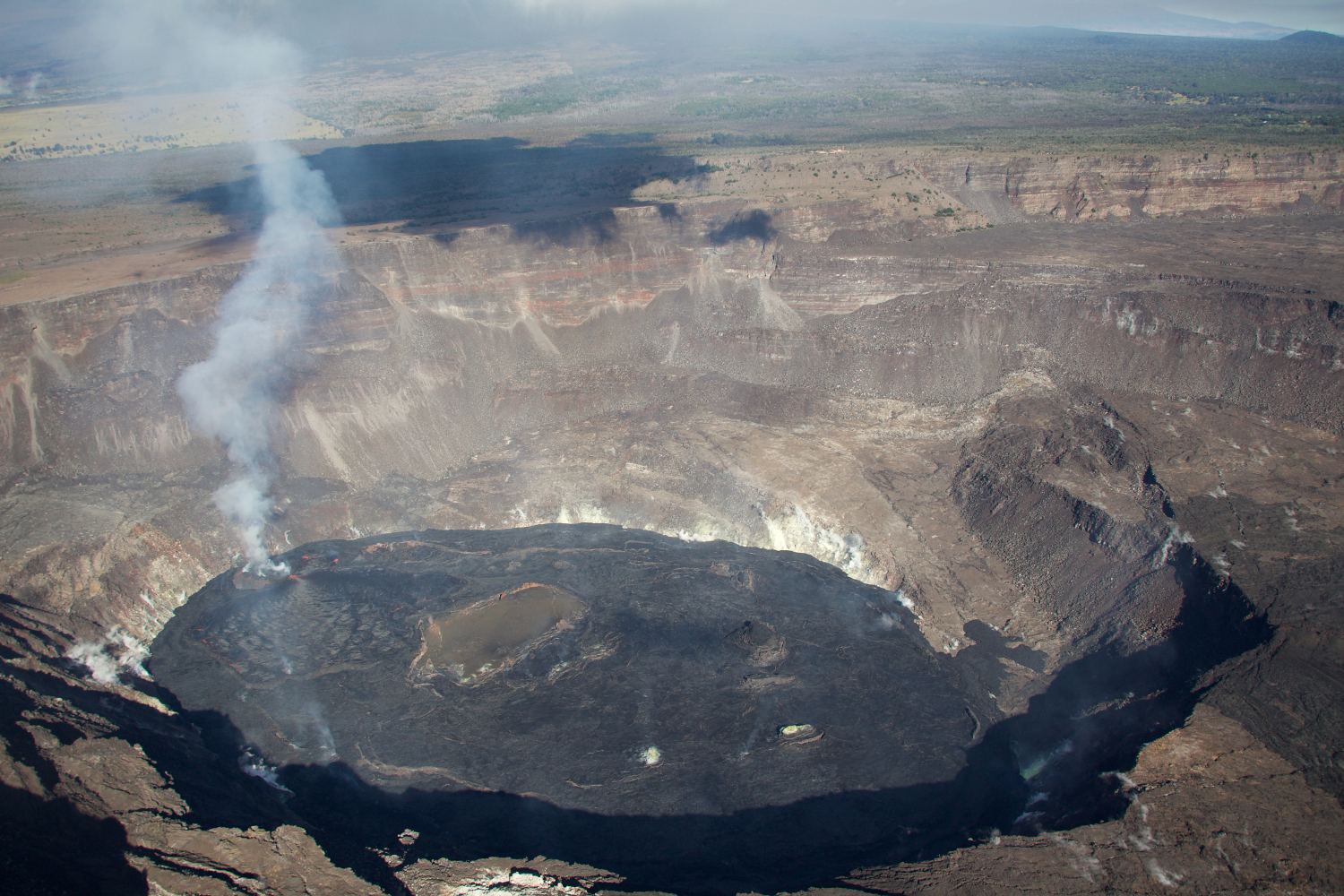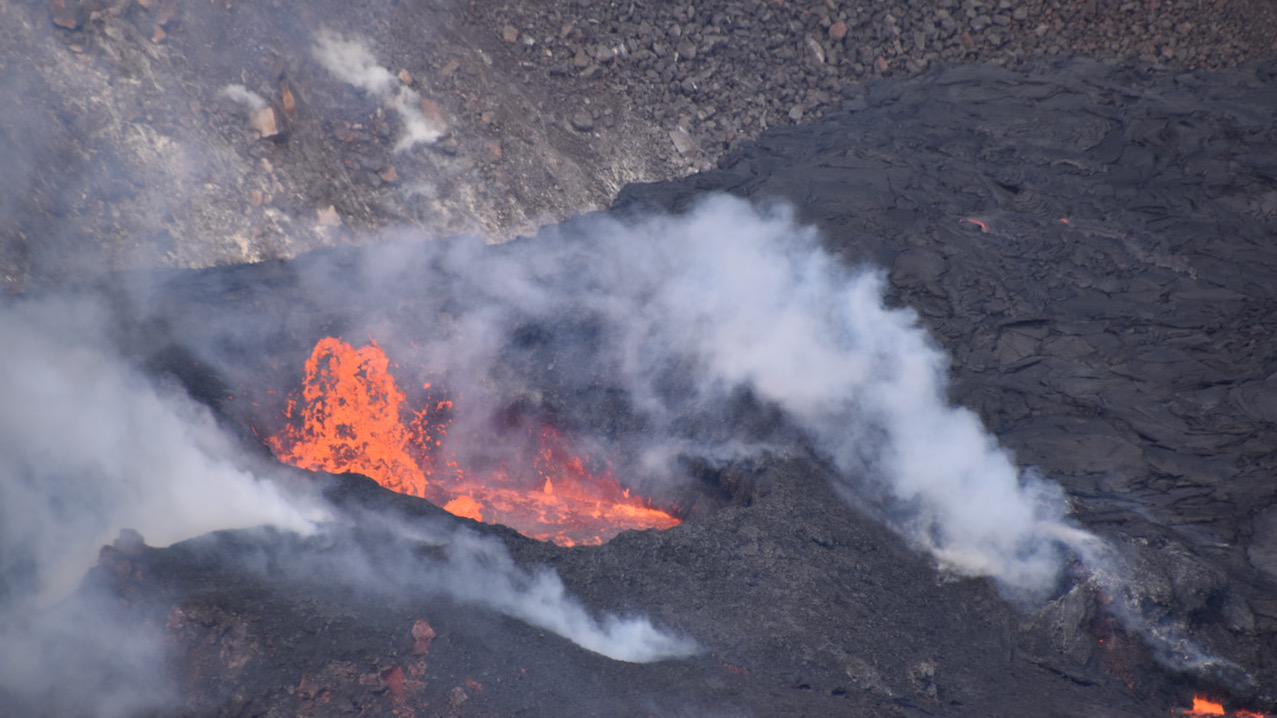
USGS: “The ongoing eruption at Kīlauea summit continues to fill Halemaʻumaʻu crater with lava. A gas plume rises from the active vent on the west (left) side of the crater as lava flows from the vent into the rising lava lake (black surface). An overflow onto the lowest visible down-dropped block on the east (right) of the lava lake occurred on November 15. Above the block with the overflow, the edge of the largest down-dropped block stretches from bottom- to center-right.” (USGS photo taken by N. Deligne on November 16)
(BIVN) – Kīlauea volcano continues to erupt from a single vent in the western wall of Halemaʻumaʻu crater. All lava activity is confined within to the summit in Hawai‘i Volcanoes National Park.
In this week’s Volcano Watch article, Brett Carr – a geologist and Mendenhall postdoctoral researcher at the Hawaiian Volcano Observatory – writes about the current activity at Halemaʻumaʻu.
Halemaʻumaʻu crater has undergone repeated changes during the past two centuries. Prior to 1924, the size and shape of the Halemaʻumaʻu lava lake changed frequently and lava commonly spilled out across the floor of Kīlauea caldera.
After the 1924 collapse of Halemaʻumaʻu, the outline of the crater remained amazingly constant until 2018. Ephemeral lava lakes came and went, especially during the 1950s and 1960s, and culminated with the 2008–2018 lava lake.
The most significant recent change at Kīlauea’s summit occurred in 2018 when the floor of Halemaʻumaʻu crater collapsed 500 meters (1640 ft) and the volume of the caldera increased by almost a cubic kilometer (0.2 cubic miles).
The 2018 eruption and summit collapse of Kīlauea ended a period of continuous flank and summit activity that had persisted for decades. A period of quiet uncertainty followed the 2018 events. This ended with the return of eruptive activity at Kīlauea’s summit in December 2020. The main characteristic of the new activity is clear, these eruptions are refilling Halemaʻumaʻu crater.
Kīlauea erupted for the first time since 2018 on December 20, 2020. Lava poured from vents on the walls of Halemaʻumaʻu crater into the water lake, which boiled away in a matter of hours. The eruption formed a new lava lake and lasted for five months. The lava lake filled in 226 m (740 ft) of Halemaʻumaʻu crater with 41 million cubic meters of lava (54 million cubic yards, or enough to fill 16,000 Olympic-size swimming pools).
Kīlauea erupted again on September 29, 2021. Vents opened in the center of the older lava lake and on the walls of Halamaʻumaʻu. The lava lake began to rise and continue to fill the crater. As of this week, lava is still erupting from a single vent in Halemaʻumaʻu and has added a total of 30 million cubic meters (39 million cubic yards) to the volume of the lava lake.
Lava has now refilled Halamaʻumaʻu more than half the distance it collapsed in 2018. The lava lake is 282 m (925 ft) deep. But, Halemaʻumaʻu is in no danger of filling and overflowing anytime soon. The 71 million cubic meters (93 million cubic yards) of lava that has erupted in the past year account for less than 10 percent of the 1 cubic kilometer volume that collapsed in 2018.

USGS: “This plot shows the elevation of Halemaʻumaʻu crater along a line running from west (left) to east (right). The pre-2018 collapse line (blue) shows the relatively shallow depth of Halemaʻumaʻu during the lava lake period of 2008–2018. The post-collapse (2019) elevation line is black, showing that 500 m (1640 ft) of collapse occurred during the 2018 eruption. The eruption which began in December 2020 created a lava lake that reached a depth of 226 m (740 ft) by May 2021 (green line). The current eruption has caused the lake surface to rise another 60 m (200 ft) and overflow a down-dropped block (red line).”
The rising lava lake is slowly covering the irregular terrain left after the caldera floor collapsed in 2018. When the floor collapsed, many areas remained intact as they fell, forming a series of relatively flat surfaces at different elevations within Halemaʻumaʻu. HVO scientists call these areas “down-dropped blocks.”
The lowest of these blocks was covered by lava on the first day of the eruption in December 2020. Another down-dropped block on the south side of the crater contains a segment of the old Crater Rim Drive that can be seen from multiple Hawai‘i Volcanoes National Park viewing areas.
Lava reached the rim of the next lowest down-dropped block to the north and east of the lava lake earlier this month. Last week, lava overflowed onto this block, covering an area about the size of 2 football fields (about a hectare or 2.3 acres). As the lake surface continues to rise, lava will further spread over this block.
Greater volumes of lava are needed for each increase of 1 meter of lake level rise because the width of the crater increases with elevation. At this point, more than 670,000 cubic meters of lava (875,000 cubic yards) needs to erupt to raise the surface 1 m (3 ft)—at the current eruption rate, this takes about 2 days. Lava still has another 100 m (330 ft) to go before it reaches the elevation of the largest down-dropped block (and another 150 m (500 ft) above that to reach the caldera floor). At that elevation, 1.4 million cubic meters of lava (1.8 million cubic yards) will need to erupt to raise the lava surface 1 m (3 ft), twice the current amount.
An important question for HVO scientists is whether this period of refilling is a prelude to an era dominated by summit eruptions, similar to pre-1924 activity, or whether it is the prelude to increased rift zone activity, like what followed the summit lava lakes of the 1950s and 1960s. Either way, change is the one constant at Kīlauea.


by Big Island Video News10:15 am
on at
STORY SUMMARY
HAWAIʻI VOLCANOES NATIONAL PARK - Lava has now refilled Halamaʻumaʻu more than half the distance it collapsed in 2018.